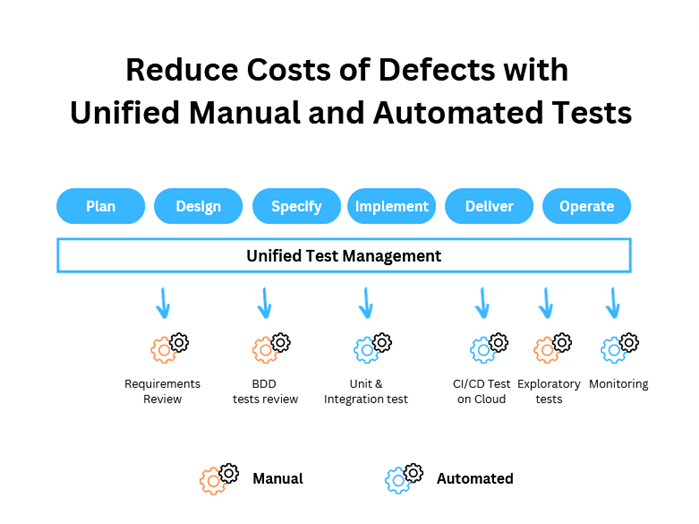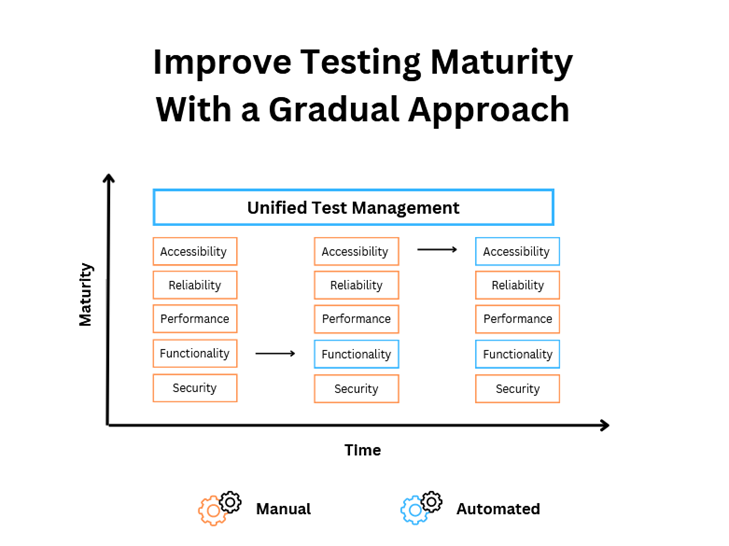
On one side, manual tests are easier to start with and to adapt based on experimentation, but on another one, automated tests can scale better with an increasing number of applications and tests, given that automation is implemented and maintained properly.
Software teams faced with the challenge to deliver Quality at Speed software have to make rapid choices when it comes to implement manual or automated tests; and the answer stops the debate that confronts these two worlds, leaving room for combining them.
By combining the strengths of both manual and automated tests, organizations can achieve better test coverage, improved accuracy among others and gain in efficiency, minimizing the limitations of each test typology.
This article highlights 5 key advantages of unifying manual and automated testing, providing insights on how organizations can maximize these benefits in their software testing and quality strategy.
3. Brings Flexibility to Adapt Fast
5. Optimize Testing Efficiency
Deliver Better, Deliver Faster
Software codebases are continuously evolving to support the evolution of requirements and technologies. While these changes are necessary to support the business, they make it hard to keep an up-to-date source of truth of requirements and test statuses.
From one side, the product has to evolve fast to meet the demand of the users, pressuring to deliver software changes at speed. On another side, quality requirements must be kept up to date to execute tests supporting the early detection of defects.
The deployment of isolated manual and automated tests creates a fragmented view of tests across the organization resulting in multiple issues.
The good practice is to use a central test management solution to keep a central quality requirements referential, above organizational silos and tooling, unifying manual and automated tests.

Figure 1: Testgear.io provides the big picture for all of your tests.
The central test referential maintains the big picture acting as the single source of truth for requirements and how they should be verified, wherever manually or automatically, and interconnected with specific tooling to run the tests.
Maintaining the unified test referential as the master of requirements and tests is a necessity to abstract the increasing complexity and allows to change the internal implementation of tests from manual to automated, or through different technologies.
Quality is about satisfying multiple attributes ranging from functionalities, performance, security, usability, and accessibility, among others. The multidimensional aspect of quality is what makes it necessary to define in each context, but also hard to fulfil.
Meeting the quality requirements is a main challenge for software teams having the pressure to deliver faster. The probability of missing quality requirements increases with less time available, so teams have to find optimized ways to satisfy the quality requirements.
Combining manual and automated testing is one effective way to increase the coverage of quality requirements.

Figure 2: Combining manual and automated tests on multiple quality requirements.
Manual tests are very effective for one-shot tests or for tests harder to automate but can be slower and error-prone with an increasing number of tests. On the other hand, automated tests are best suited for repetitive non-regression tests.
Teams that unify both approaches cover much more quality requirements with the same or less efforts. They can leverage external accessibility testing platforms, while keeping manual exploratory tests for product teams, and automated with QA engineers.
Minimizing the cost of rework requires to avoid defects in the first place by design, and when found, fix them as early as possible. Their detection depends on knowing the quality requirements, to then verify them on a continuous basis.
The difficulty for software teams is to perform multiple testing in parallel and as soon as they can be run, considering the constraints of each testing technique. For instance, exploratory tests may require solid data tests, whereas integration tests can simulate the input and output to verify the behaviors of the systems.
Once again, a unified view of manual and automated tests allows the management of the end-to-end test constraints.

Figure 3: The unified referential allows testing as early as possible for defects.
The unified test referential handles the requirements execution and constraints to test as early as possible depending on the capabilities and limitations. As a result, teams can perform test campaigns much faster with a clear focus.
The benefits for organizations are to reduce the cost of rework by detecting as early as possible deviations from quality requirements and adapt the code as near as possible from its production by the development team.
Teams relying only on either manual or automated tests quickly face limitations of implementation delay, maintenance issues, or team availability. The main issue is the time lost by the business and development while waiting for test results to move forward.
The unified hybrid approach provides more options to adapt better to the changing context and, as a result, keep iterating at speed. The main case is to switch to manual tests when automated tests are not doable, but switch from manual to automation can also be done for specific times of tests an organization may prefer to keep internally by default.

Figure 4: TestGear keeps the test steps decoupled from a manual or automated execution.
The flexibility to use manual or automated tests enables to verify quality requirements under the project's constraints. If the team does not have the time to automate tests for new requirements, they can perform them manually and automate at the end of the sprint.
The increasing margin of choice remains on a continuous basis to face uncertainties the team can face. If an automated testing farm is down without a backup plan, the team can quickly switch to manual testing having the referential available.
Adopting new practices is necessary for software teams working with technology in continuous evolution. Quality and testing practices are no exception and do represent challenges for organizations to grow in maturity.
One difficulty lies in the transversality of the practices. Learning test accessibility requires to understand first accessibility, testing, to then see apply testing in that area. The same goes on for other test typologies like usability, performance, security, among others.
The advantage of unifying manual and automated tests is to support a more gradual learning curve.

Figure 5: Unified Test Management supports a gradual testing maturity.
Teams start by having the big picture of quality requirements consolidating them in a unified referential like TestGear. From there, they can initiate manual testing practices to not add the automation complexity at first and verify how they can satisfy the quality requirements.
Once the team has grown in testing maturity in specific areas, more complex methodologies and techniques can be added up. The main benefit is that the teams have already captured value early on, without waiting weeks or months to be trained.
Testing activities are not always seen as added value at first sight, requiring the need to defend a budget for its implementation. And once the organization perceives that it can accelerate with more confidence, testing must be efficient to remain of value to the teams.
The speed and reliability of tests are critical to remain integrated within the software lifecycle. Speed is necessary to keep providing fast-feedback loops to the team that will not wait hours to get the results; reliability gives confidence that test results can be trusted.
Increasing the testing efficiency is achieved by using the right tool for the right job:
Software teams can ensure to use the most appropriate and cost-effective testing method by using a combination of manual and automated testing techniques, capitalizing on its experience to build reusable standards even more efficiently.
The priority of the team is not to automate, but to find the most effective way to ensure the quality requirements. That perspective contributes to creating a team that focuses on delivering value to the organization rather than solely on testing considerations.
Teams with the imperative to accelerate the delivery of code changes that meet the multiple quality requirements need efficient testing practices that directly depend on how the tests are organized across the company.
Improving anything requires first having a clear view of the scope of work and what are the key objectives. A unified test referential for manual and automated tests provides that consolidated view of the scope to optimize its usage for the organizations.
More artificial intelligence and intelligent features as part of testing products will help to switch part of testing activities to automated solutions. Nevertheless, there is still a long way to go with both manual actions and automated tests requiring collaboration.
Start today to unify with TestGear, the single place for manual and automated tests.
Written by Antoine Craske, member of the TestGear community.